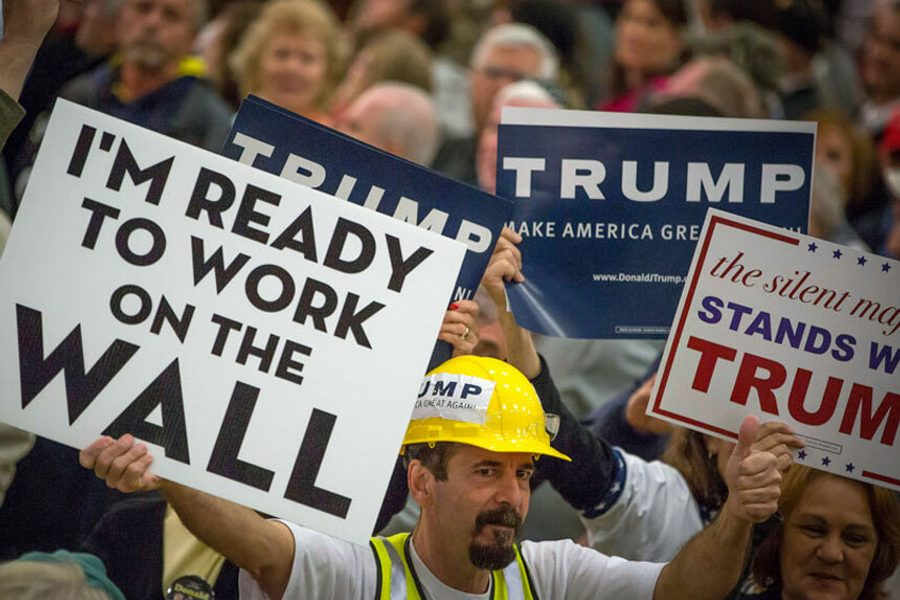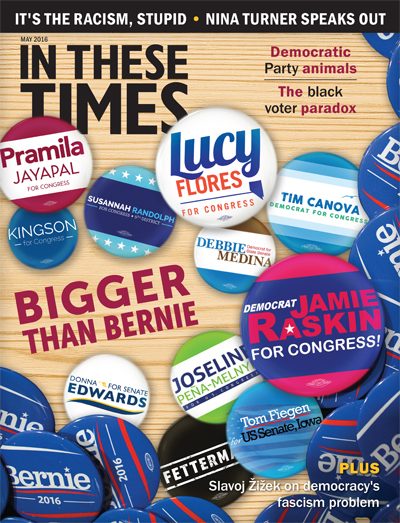Understanding What Makes Donald Trump Voters Tick: Is It Just Racism?
In Trump’s appeal, the Left seeks clues on winning back the white working-class.
Ian Haney López and Matt Morrison

Even as Donald Trump fans cheer on his not-so-veiled barbs at Muslims, Mexicans and immigrants, some progressives see opportunity.
“A map of [Trump’s] support may coordinate with racist Google searches, but it coordinates even better with deindustrialization and despair, with the zones of economic misery that 30 years of Washington’s free-market consensus have brought the rest of America,” writes Thomas Frank, author of What’s the Matter with Kansas and most recently Listen, Liberal, in a recent Guardian op-ed. “What this suggests is that he’s telling a tale as much about economic outrage as it is a tale of racism on the march.”
No one disputes that racism is a force behind Trump’s appeal. But in looking at broader factors, Frank and others seek clues to a puzzle that has stymied the Left for decades: how to counteract the GOP’s Southern Strategy and convince the white working-class to choose economic self-interest over racial bias.
To make the case that the Trump voter is not beyond salvation, we invited Matt Morrison, deputy director of the AFL-CIO’s 3.2-million member community affiliate, Working America, to this month’s roundtable. In December 2015 and January 2016, Working America surveyed more than 1,600 white working-class voters about their opinions on this year’s election.
To consider how racism and economic anxiety intersect, we reached out to Ian Haney Lopez, author of Dog Whistle Politics: How Coded Racial Appeals Have Reinvented Racism and Wrecked the Middle Class and of a recent white paper for the AFL-CIO urging unions to work for racial and economic justice simultaneously.
HANEY-LOPEZ: Racism is the core of Trump’s appeal. This is the man who opened his campaign by calling Mexicans rapists and promises to drive out millions of migrants “so fast your head will spin.” He threatens to build an enormous wall on the southern border — that Mexico will pay for. And that’s milquetoast compared to what he says about Muslims, adherents of a religion that supposedly “hates America.” What’s needed, according to Trump: “A total and complete shutdown of Muslims entering the United States.” As for the never-ending “war on terrorism,” he promises to do “a hell of a lot worse than waterboarding.”
Nor do you have to rely on his comments; look at his supporters. And I don’t just mean David Duke, the Klan, and the rest of the white supremacist krazies. (Though don’t discount them, either: America’s most popular neoNazi news site, the Daily Stormer, endorsed Trump early on, urging white men to “vote for the first time in our lives for the one man who actually represents our interests.”)
Trump’s base is far broader. In fact, his popularity dwarfs that of the other GOP candidates across every major division among conservatives: gender, age, ideology and, yes, class. Where the breadth of this support perplexes some, I see race again, for the GOP today draws roughly 90 percent of its support from white voters. It is white identity that unifies the otherwise disparate conservative movements in the United States.
But don’t understand “white” as just skin tone or eye color. Whiteness is instead an orientation, a worldview, a perspective that views society — consciously or unconsciously — in terms of color-coded scales of human worth. Whiteness sees some as decent, deserving, innocent and fully human, and others as the opposite. Among conservatives, some more than others are deeply committed to whiteness as an organizing principle — more likely to root their political identity in perceived racial threats than in positions regarding free markets or the importance of institutional stability. It is among these racially fearful conservatives that support for Trump surges.
But wait: Does this mean it’s race, after all, and not class that drives Trump’s support? Absolutely not. Fueling Trump’s rise are the two great fears many whites face in the United States — demographic change and economic insecurity — and Trump’s greatest success lies in how he has fused these together into searing panic.
MORRISON: It’s hard to argue that Donald Trump is not a racist. Since joining the presidential race, he has used misogynist, racist rhetoric to exploit the racial anxieties of white working-class voters who have seen their wages and economic prospects erode over the past generation. What makes Trump so dangerous is the way in which he fuses anti-elite sentiments, economic populism, xenophobia and bigotry.
For 13 years, Working America, the community affiliate of the AFL-CIO, has been organizing its members, including a large segment of white working-class communities, around their economic anxieties and aspirations. To better understand how the Trump phenomenon and right-wing populism impact our membership, we set out to talk to voters about their views of the candidates and the issues they care about.
In the five weeks between Dec. 18, 2015, and January 22, Working America canvassers spoke with 1,689 voters in swing areas near Cleveland and Pittsburgh — 90 percent of whom had voted in 2012, and 98 percent of whom had household incomes below $75,000.
We found these voters were deeply concerned about the economy and about their fates in a time of rapid change. We also found that for a portion of these voters, Trump’s attacks on immigrants, African Americans and Muslims were extremely salient. But we also talked to working-class people who found some of Trump’s economic rhetoric attractive — and the candidate less so. These non-college educated white swing voters ranked “jobs and the economy” as their top concern. And this is the opening for progressives.
It is difficult to separate legitimate anger at the status quo from bigotry and dog-whistle appeals. But rather than parse out that distinction, the question before us is how we counter the Right’s divisive, racist rhetoric with a message that finds common ground with white working-class voters.
One answer is to talk with, not about, them. For waffling white working-class voters, we found that when we focused the conversation on issues, not personality, many working-class people were eager to hear new information and actually engage in a discussion instead of a yelling match. Connecting voters with more and better information can shift hearts and minds. We found that if we provide people with a systemic target for their economic woes and anxieties instead of focusing on “the other,” we can begin to counter bigotry.
IAN: Implicit in Matt’s response about using “jobs and the economy” to open a conversation and focusing on “issues, not personality” is an analysis that goes like this: Let’s build solidarity by focusing on what unifies us, class, rather than what divides us, race. This approach is pursued across the broad Left, from centrist liberals to radical Marxists, but in the context of the United States, it misses the inseparable connection between race and class.
Class is more than just one’s income or even one’s relationship to modes of production; it’s an ideological construct that justifies (or challenges) existing distributions of power and wealth. This is why class consciousness is never natural but is always contested and hard fought. Plutocrats vigorously propagate conceptions of class that disempower working people and generate popular support for social arrangements that overwhelmingly benefit the very wealthy.
Too abstract? Here’s the concrete version: Donald Trump, just like the Republican Party for the last half-century, has been strategically linking economic issues to racial anxieties, seeking to create a political consciousness among working people that blames our wrecked economy on dark and dangerous people of color rather than on the plutocrats who, like Trump, rule — and ruin — the world. When Trump rails against nonwhites, he’s doing much more than activating prejudice; he’s shaping class consciousness, encouraging whites to see the dangerous few not as the bosses but as blacks and browns.
“I am also ‘unemployed’ (forced early retirement) and unable to get a job because, in my perception, I am too old, male and white,” a Trump supporter told The Guardian. Another said, “I have friends who go out and they can’t find jobs because they’re always hiring Mexicans, these illegal immigrants to do their jobs.”
This is dog-whistle politics in its full form. It’s not simply the use of coded racial narratives designed to stimulate prejudice and fear. It’s an invidious effort to craft a worldview that trashes social solidarity among workers, while building a false rapport between working-class whites and the financial titans who’ve hijacked government and rigged the economy. Working people may vote for Trump’s wall or his ban on Muslims, but what we’ll get is massive tax cuts for the very rich.
This points to the way forward. Progressives cannot succeed by ignoring race in favor of class, because race is central to the lies the billionaires tell white working-class families about their economic position and their social status. Instead, we must hammer home a new, simple truth: When racism wins, everyone of every color loses. The fate of the white working class — their jobs and pensions, their neighborhoods and schools, the ladders of upward mobility for their children — depends on this country recognizing and repudiating race as a weapon of political and economic manipulation.
Working America, in its recent conversations with white working families, found that as of December 2015 and January 2016, more of its constituents supported Donald Trump than Hillary Clinton and Bernie Sanders combined. We can’t turn this around by ignoring the strategic framing of class concerns in racial terms. To wrest our country back from the plutocrats, we must talk to whites about race together with class. Only in this way can we create a true 99% coalition, undivided by racial fears, unified in rejecting dog-whistle politics, and unanimous in a renewed commitment to including all of us in “we the people.”
MATT: We agree: Donald Trump has been “strategically linking economic issues to racial anxieties” to encourage working people to blame their economic insecurity on immigrants and people of color rather than plutocrats or systemic injustice.
The question before us: How can we disrupt that ugly conflation in a way that changes minds — and votes? An engaged, respectful conversation on the voter’s doorstep is where we begin.
Working America reaches a broad swath of black, Latino and white working-class constituents. And we have unique expertise with white workingclass moderates and independents who seldom hear from progressives. We offer these voters the opportunity to rethink their views in light of different information.
And many do.
Millions of face-to-face conversations (1.9 million projected this year alone), hundreds of successful campaigns and dozens of clinical tests affirm that conversations that begin by acknowledging voters’ concerns can start to reshape their initial opinions. This type of engagement can move a person from “immigrants are taking my jobs” to “management is hiring vulnerable workers to force wages down for everyone.”
Ian missed an important finding of our Front Porch Focus Group report: Half the white working-class voters we spoke with had yet to make up their minds. The majority were much more concerned about jobs and the economy than about immigration. And people were eager to talk, hungry for reliable intel. We were able to provide an alternative view and begin to change the perspectives of many of these voters.
To understand the impact of these interactions, look at the math from the last presidential elections. We learned how to successfully move some of the toughest swing neighborhoods in the country. In 2012, Obama won 39 percent of the white vote nationally. In Ohio, he won 41 percent of the white vote. Without those 2 points, he would have lost the state.
The math for 2016 is equally sobering: If the Democrats cannot bring along at least 40 percent of the white working class in critical states, we will not be able to win the presidency; and without those same voters, we will not be able to elect a Senate that advances progressive goals.
In the end, it’s not about elections but about the kind of democracy we are day to day, year to year. A conversation with a canvasser can’t unseat generations of prejudice, but our work opens the door to people reconsidering Trump’s racism and misogyny — and to preventing future Trumps from gaining such potency.
To forge a progressive movement that can win elections, govern well, foster greater equity and enlarge our base, we need an ecosystem of organizations that reach wide and deep to engage voters across all the communities in which we work. If we do this, we can win this November and beyond.

I hope you found this article important. Before you leave, I want to ask you to consider supporting our work with a donation. In These Times needs readers like you to help sustain our mission. We don’t depend on—or want—corporate advertising or deep-pocketed billionaires to fund our journalism. We’re supported by you, the reader, so we can focus on covering the issues that matter most to the progressive movement without fear or compromise.
Our work isn’t hidden behind a paywall because of people like you who support our journalism. We want to keep it that way. If you value the work we do and the movements we cover, please consider donating to In These Times.




